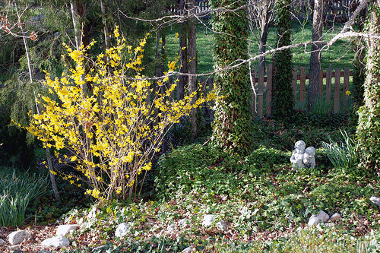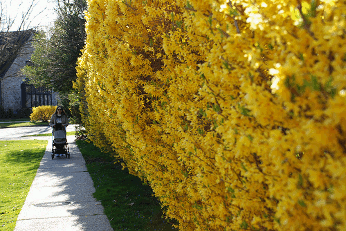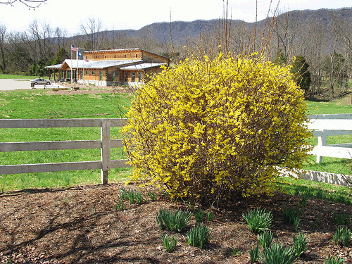|
The good thing about forsthia
is that you can choose whether you want a natural, unpruned look or a
tidy, organised trimmed appearance. Even if going for the natural
look, you may sometime find that you wat to do a bit of snipping to
tidy up your plant. One which has had a little care can look
stunning, especially in spring with its display of bright yellow
flowers. Fortunately pruning forsythia is quite an
easy task and can be enjoyable too.
Planting
and Planning for Future Growth
Forsythia
is a large, fast growing shrub that flowers in the
early spring. This plant is amongst those
which are often badly pruned by some gardeners. Part of
the reason for this can stem from when the plant was
young. Unfortunately, people tend to underestimate
the growth potential of these plants, and end up giving them too
litte space
to spead and expand. If inadequate space is given to
the shrub for its growth before it
reaches its full mature size, it can start to overrun into
areas that you had not planned for it to be. When this
happens, some
gardeners take drastic measures to try to keep the bush within
the
small space allocated to it. However, nature will have its
own way.
If a plant wants to grow, it will, and with the rapid speed
of growth
that forsythia possesses, a plant which is overly-confined will keep
trying to spread out.
When
you are deciding on positioning and planting your forsythia, remember
therefore that although you may only start with a tiny twiggy
structure, you should
plan ahead for the time when your plant reaches its adult size.
You will find that Forsythia bushes grow up to 3
metres tall and wide. Take this into consideration
and you'll avoid future heartache.
The
Best time to
Prune Forsythia Bushes
Many
gardeners give their forsythia bushes a pruning once a year but it is
entirely up to you how often you wish to trim your plant. You could go
for years without pruning, or could give them a snip every few
months. Commonly,
pruning Forsythia is done in late Spring, just after the plant
has
flowered. Instead of this, waiting until later in the year
until the
flowers have gone is
often a better idea. Without the flowers in the way you can
look at
the branching structure
and more easily plan your snipping and trimming with pruners
and loppers.
If you have a case
of a badly shaped or overgrown plant which you do choose to prune just after it
has flowered, then get
ready for a bit of heartache as you lose lots of those
lovely blooms.
Don't let them go to waste though - you could create some
lovely
cut-flower displays using the snipped twigs. Use these to
decorate
your home or give to family or friends. Maybe there's a local
residents group who meet near you who would appreciate a display to
brighten their meeting hall.
Techniques
for pruning Forsythia
If
trimming is required, the tallest and oldest canes should be sawn off
Branches that are hanging close to the ground
should be pruned away. The tips may start touching the ground due to
their weight and could give rise to an unnecessary new plant. Such
canes should be chopped off and the rooted bits should also be ripped
out of the ground. After this, one third of the old growth should be
trimmed off each year.
If
you find branches which are growing awkwardly or rubbing
together, they should be removed. Cut these all the way back to the
stem from which they've sprouted to ensure that they don't simply
re-grow in the same awkward shape. A few canes should be cut
from middle of the plant to open it up.
Letís
suppose your Forsythia has acquired a terrible shape or is badly pruned
and it is the case that it doesnít flower anymore. In this situation,
you should cut the entire plant in late winter. You will then have a
refreshed version of the plant later on when it grows back.
Depending on your
garden's design, you may want to try to create a symmetrical structure
to your plant. The best way to do this is to prune a bit from
one side, then go to the other side to trim a similar amount, then go
back to the first side and do some more, then over to the
opposite side again. By using this method rather
than prune everything from one side at once, it can be easer to see how
things are panning out to create the structure you want.
Once your plant is mature and reasonably dense, you may want to have
fun by trying to prune your forsythia into a particular shape.
You could sculpture a nice ball shape, or maybe a
tree by cutting your plant with a bit of artistry.
Just use a bit of imagination and let the plant's existing
structure guide you a little.
Remember that pruning
should be an enjoyable excercise for you. If you are a
beginner you may feel as though you are currently a bit rubbish at all
this pruning
lark, but don't worry, we all start like this at the beginnning.
With
time and practice your pruning will become better and it will enhance
the beauty of your forsythia plant.

|
|




